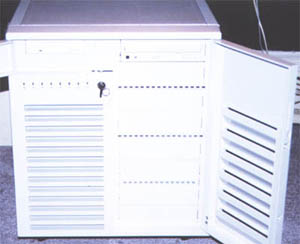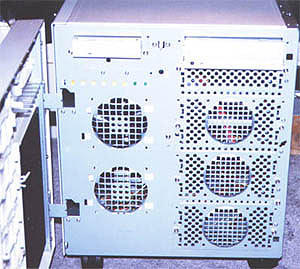|

|
| If there was ever a need to keep someone's hands off your
computer - inside or out - this is the box to get. Power and Reset
controls can be locked down, and access to the CDROMS requires a key. To
get into the case a lock at the back must be released so that the
back panel can be removed, enabling the side panels to come off. There is
also a switch there, and one at the front - to tell if either of
these doors (back and CDROM) are open when they souldn't be should
your motherboard have that kinnd of detection
capabilities. |
Access to removing CDROMs drives can be a bit tricky at first, as the entire front
cover swings open via a semi-secret latch hidden off to one corner. Each
of the drives is mounted on drive rails that have become pretty standard on any
good case, and make removal a heck of a lot easier then with a screwdriver
and the case on its side.

To switch around the FDD requires a bit more work, a couple screws must be removed after the side panel has been
removed.
Generally, to access any gear inside the case is pretty
effortless; unlock the back panel, and remove so that the side panels can be
slid off (remove two screws per side). Looking at each side gives you an
unobstructed view of everything that is there, and with no powersupply directly
atop the CPU, removing cards or reconnecting the FDD cord to an Aopen board (why do they put it there!) is a
breeze.
Internal layout
The layout of this case screams SCSI, and here's why. The motherboard is attached
to a removable tray (it makes installing the board a lot easier)
which then attaches to the partition. At the top and bottom of the
partition are spaces to feed cable through. Considering the distances involved, IDE is
not well suited to this case. It's a tight fit to get a CDROM and IDE harddrive in
the drive compartment hooked up to the motherboard with one cable. There is
a space under where the floppy goes where the harddrive could easily go, but with
the way things are configured two cables would absolutely be necessary, and that
one cable could only be used for that device. Likewise for the CDROM, don't
expect to get more then one, or possibly two devices there.
With that 18" limit to cable length, only the top 10% of this
case could realistically be used. Enter SCSI, with the cable coming from a card
or right off the board, this case is suited to many, many daisy chained
devices. Which explains all the places to put fans :-)
A good powersupply is a must for this case, not only for
Wattage, and cooling, but for the length of leads it has. The case does not come
with a powersupply (unless you want to pay a few hundred more) We chose to
use the 350W Enermax($70 CDN) we have talked about before because the
wires are about a meter long and easily reach everything in the box across the
partition. It also has two very large ball bearing fans to keep itself cool, and
exhaust some of the air from inside the case.
